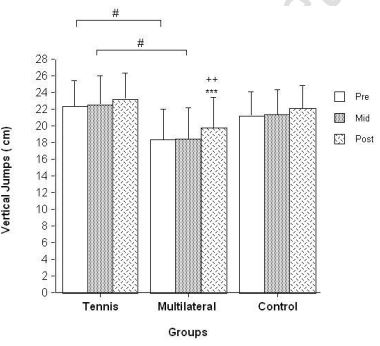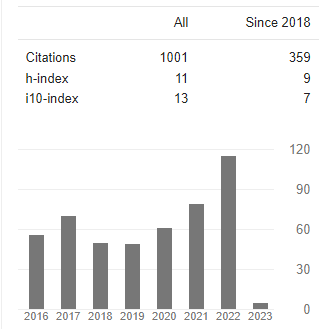EFFECTS OF SHORT TERM MULTILATERAL AND SPORT SPECIFIC TRAINING ON PHYSICAL FITNESS PROFILE OF MALAYSIAN SCHOOL CHILDREN
Abstract
The promotion of regular physical activity in children is essential, since childhood inactivity can influence future negative activity patterns in adulthood. The purpose of this study was to determine the effects of specific and multilateral training on physical fitness profile of Malaysian school children. Thirty healthy children aged 10±0.39 years, were evenly assigned to Control (PE Classes), Experimental I (PE classes plus Tennis Based Training) and Experimental II (PE classes plus Multilateral Training) groups. Experimental groups featured once weekly additional training (one of specific, another of multilateral modality). Physical fitness was assessed thrice: pre-test, mid-test (6th week) and post-test (after 12 weeks of intervention programme). Test battery included one mile walk/run test, 20 meter dash, sit and reach test, vertical jump, hexagon test, sit-ups and push-ups. One-way ANOVA and post-hoc (Tukey HSD) were performed to determine the significance of differences between groups at each time point and to determine the differences between specific means. Experimental group I displayed significant improvement in lower back flexibility after 6 weeks (p<0.05); aerobic capacity (p<0.01) after 12 weeks, speed (p<0.01) and agility (p<0.01and p<0.001) after 6 and 12 weeks respectively; abdominal and upper body strength after 12 weeks (p<0.01 and p<0.05 respectively). Experimental group II exhibited significant improvement in lower back flexibility after 6 and 12 weeks (p<0.01 and p< 0.001); speed (p<0.05), agility, power, abdominal and upper body strength (all at p<0.001) after 12 weeks of training. No significant improvements were found in control group after 12 weeks in assessed fitness components.
Downloads
References
Caspersen, C.J., Powell, K.E. & Christenson, G.M. (1985). Physical activity, exercise, and physical fitness: definitions and distinctions for health-related research. Public Health Rep. 100(2), 126- 131.
Corbin, C.B. & Pangrazi, R.P. (1998). Physical activity pyramid rebuffs peak experience. ACSM ’s Health & Fitness Journal. 2, 12.
Faigenbaum, A.D., Milliken, L.A., Loud, R.L., Burak, B.T., Doherty, C.L. & Westcott, W.L. (2002). Comparison of 1 and 2 days per week of strength training in children. Res Q Exerc Sport. 73, 416- 424.
Gambetta, V. Fun (1998). Sports Coach. 25-27. Ignico, A.A. & Mahon, A.D. (1995). The Effects of Physical Fitness Program on Low Fit Children. Research Quarterly for Exercise and Sport. 1, 85.
Jones, C.J., Rikli, R.E., Max, J. & Noffal, G. (1998). The reliability and validity of a chair sit-and-reach test as a measure of hamstring flexibility in older adults. Res Q Exerc Sport. 69(4), 338-343.
Krasilshchikov, O. (2011). Talent Recognition and Development: Elaborating on a Principle Model. International Journal of Developmental Sport Management [online], 2011, Volume 1, Issue 1. [updated December 2011], [citied 31.01.2013]. Accessible from < http://www.internationaljournalofdevelopmentalsportmanagement.com/resources/Alexno1.pdf >. ISSN: 2162-892X.
Lillegard, W.A., Brown, E.W., Wilson, D.J., Henderson, R. & Lewis, E. (1997). Efficacy of strength training in prepubescent to early postpubescent males and females: effects of gender and maturity. Pediatr Rehabil. 1, 147-157.
Malina, R.M., Bouchard, C. & Bar-Or (2004) Growth, Maturation and physical activity, 2nd edition Champaign: Human Kinetics.
Pate, R.R. & Shephard, R.J. (1989). Charateristics of physical fitness in youth. Persp Exer Sci Sports Med. 2, 1-45.
Rowland, T.W. (1985). Aerobic response to endurance training in prepubescent children: a critical analysis. Med Sci Sports Exerc. 17(5), 493-497.
Sanderson, L. (1989). Growth and development consideration for the design of training plans for young athletes. World Athletics Symposium. 10(2).
Telama, R., Leskinen, E. & Yang, X. (1996). Stability of habitual physical activity and sport participation: a longitudinal tracking study. Scand J Med Sci Sports. 6(6), 371-378.
Weltman, A., Janney, C., Rians, C.B., Strand, K., Berg, B., Tippitt, S., Wise, J., Cahill, B.R. & Katch, F.I. (1986). The effects of hydraulic resistance strength training in pre-pubertal males. Med Sci Sports Exerc. 18(6), 629-638.
Wilkinson, Susan & Williamson, K.M. (1996). Gender and Fitness standards. Woman in Sport & Physical Activity Journal. 5, 1.















